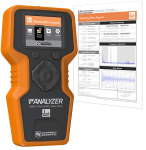概览
AVW216 无线振弦式接口包括一个内部2.4 GHz的射频电台用于无线通讯。该频率适用于全球范围。该接口允许我们的数据采集器测量无线振弦式应变计,压力传感器,压强计,斜度仪,压式传感器等。这些传感器精确、耐用并且稳定,被广泛应用于建筑、水文和地理地质等方面。
优势与特点
- Provides better measurements by significantly reducing incorrect readings caused by noise sources
- Interfaces two vibrating wire sensors; more sensors may be connected if an AM16/32B multiplexer is used
- Self-checking diagnostics give continual feedback on sensor condition
- High resolution—less than 0.001 Hz (industry standard is 0.1 Hz)
- Low current drain
- Remote, wireless operation with on-board radio
- Interfaces both temperature and frequency measurements from vibrating wire sensors
图像




3D/CAD 文件:
技术说明
AVW216 采用振弦光谱分析技术(VSPECT),首先获取传感器的信号,进行傅里叶变换和频谱分析。在过滤环境和电气噪声的同时,通过识别可接受范围的最大信号,来确定传感器的频率。AVW216 具备自诊断功能,例如振动元件的信号强度、信噪比、衰减率和错误的信号响应,这些诊断可以在后台运行,持续反馈传感器的状况。
AVW216 通常通过与数据采集器连接的RF416射频电台进行数据传输。AVW216也可直接与数据采集器连接。
产品规格
| -NOTE- | Electrical specifications are valid over a -25° to +50°C range unless otherwise specified. Non-condensing environment required. |
| Operating Temperature Range | -25° to +50°C |
| Internal Radio Frequency Range | 2.450 to 2.482 GHz |
| Radio Power | 50 mW |
| Number of Vibrating Wire Sensors Measured | Up to 2 vibrating wire sensors can be connected to the analyzer module. Additional sensors can be measured by using an AM16/32-series multiplexer. |
| Power Requirements | 9.6 to 16 Vdc |
| Analog Input/Outputs | 2 differential (DF) vibrating wire measurements (V+ and V-) and 2 single-ended (SE) ratiometric resistive half-bridge measurements (T+ and T-) for vibrating wire sensor's onboard temperature sensor. |
| Digital Control Ports |
3 digital control ports (C1 – C3)
|
| RS-232 Port | 1 9-pin RS-232 port (for connecting to a data logger COM port) |
| Measurement Resolution | 0.001 Hz RMS (±250 mV differential input range; -55° to +85°C) |
| Measurement Accuracy | ±0.013% of reading (±250 mV differential input range; -55° to +85°C) |
| Input Voltage Range | ±250 mV (differential) for vibrating wire inputs |
| Common Mode Range | ±25 V |
| Baud Rates | Selectable from 1200 to 38.4 kbps (ASCII protocol is one start bit, one stop bit, eight data bits, and no parity.) |
| Memory |
|
| Dimensions | 21.6 x 11.18 x 3.18 cm (8.5 x 4.5 x 1.2 in.) |
| Weight | 0.43 kg (0.95 lb) |
Typical Current Drain @ 12 Vdc |
|
| Quiescent, Radio Off | ~0.3 mA |
| Radio Duty Cycling 1 s | ~3 mA (includes quiescent current) |
| Radio Always On | ~26 mA (radio transmit current 100 mA) |
| Active RS-232 Communication | ~6 mA (3 s after communication stops, the current will drop to the quiescent current) |
| Measurement | ~25 mA (averaged over the 2 s) |
兼容性
Please note: The following shows notable compatibility information. It is not a comprehensive list of all compatible products.
数据采集器
| Product | Compatible | Note |
|---|---|---|
| 21X (retired) | ||
| CR10 (retired) | The CR10 supports the SDI-12 mode only. | |
| CR1000X | ||
| CR10X (retired) | The CR10X supports the SDI-12 mode only. | |
| CR200X (retired) | ||
| CR206X (retired) | ||
| CR211X (retired) | ||
| CR216X (retired) | ||
| CR23X (retired) | The CR23X supports the SDI-12 mode only. | |
| CR295X (retired) | ||
| CR3000 (retired) | ||
| CR500 (retired) | ||
| CR5000 (retired) | The CR5000 supports the SDI-12 mode only. | |
| CR510 (retired) | ||
| CR800 (retired) | ||
| CR850 (retired) | ||
| CR9000C (retired) |
固定设备
| Product | Compatible | Note |
|---|---|---|
| ENC10/12 | If using the RS-232 port, the AVW216 must be mounted flat to fit in an ENC10/12. | |
| ENC10/12R | If using the RS-232 port, the AVW216 must be mounted flat to fit in an ENC10/12R. | |
| ENC12/14 | If using the RS-232 port, the AVW216 must be mounted flat to fit in an ENC12/14. | |
| ENC14/16 | ||
| ENC16/18 | ||
| ENC24/30 | ||
| ENC24/30S |
Additional Compatibility Information
Sensors
The AVW216 Vibrating Wire Spectrum Analyzer Module allows our data loggers to measure vibrating wire strain gages, pressure transducers, piezometers, tiltmeters, crackmeters, and load cells.
Communications
The AVW216's internal spread-spectrum radio can transmit data to other AVW216 analyzer modules, RF416 spread-spectrum radios, and RF432 spread-spectrum radios. The AVW216 does not have a transparent mode, and therefore its internal radio cannot communicate with the RF415 radio.
Enclosure Considerations
The AVW216 requires a desiccated, non-condensing environment. A Campbell Scientific enclosure is recommended when the analyzer module is in the field. The AVW216 has built-in keyhole flanges for mounting to an enclosure backplate.
Power Considerations
The AVW216 is typically powered by the data logger's power supply.
常见问题解答
AVW216: 12
展开全部收起全部
-
No. An AVW206, AVW211, or AVW216 is not capable of communicating with other AVW200-series modules.
-
-
The AVW200-series modules are not required, but they do reduce the chance of erroneous readings by filtering electrical noise that is sometimes present.
-
Two probable causes are the following:
- The SerialOpen() instruction has not been added to the data logger code.
- The correct PakBus address setting has not been used in the AVW200 instruction.
-
It takes 2 s for the AVW200-series modules to acquire a measurement from each sensor. An AVW200-series module servicing two AM16/32B multiplexers, each with 16 vibrating wire sensors, requires approximately 64 s to acquire data.
-
The AVW200 must be wired directly to the data logger via a cable.
The AVW206, AVW2011, and AVW216 have built-in spread-spectrum radios tuned to different frequencies that allow the data logger to communicate with a remote AVW device through an appropriate radio link.
-
Yes, using a null modem cable.
-
Dozens of AVW200-series modules can be accessed through one CR1000. The limiting factor is the frequency at which the CR1000 is set to retrieve data from each module. If the CR1000 needs to collect data very frequently from the modules, fewer AVW200-series modules can be accommodated in the time between data collection events.
-
Use pn 17855, Data Cable, RS-232 Male to Pigtail.








